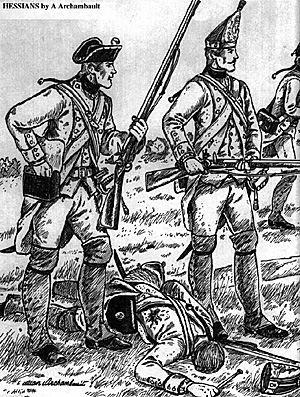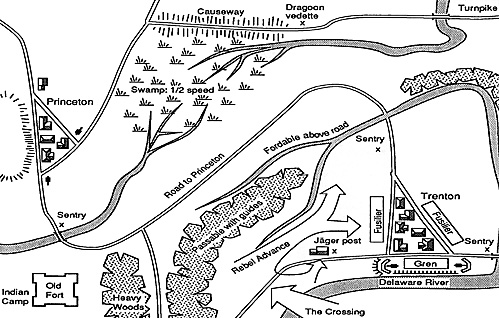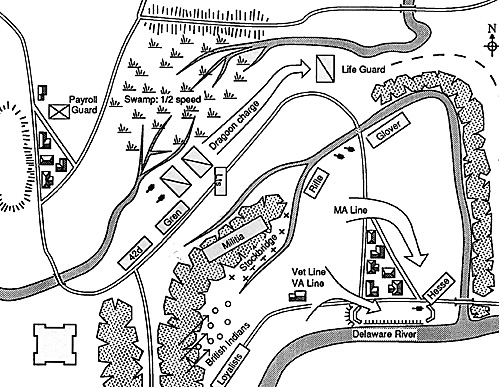The setup of the map is a good illustration of a successful attempt to incorporate a number of features which help make for an interesting scenario. Model Railroaders often use serpentine routes for their track paths to give the illusion of distance. Where the road is unrealistically close, blocking terrain is used to force the use of the longer way. The actual table size was 6'x 8'. By placing the two major towns at opposite corners and using an "S" curved road, the distance is maximized. A generous road bonus (double) is given to troops in column, and any attempt to move across the width of the table is encumbered by heavy woods streams, and a swamp. This makes the roads the most desirable lines of movement and provides tactical focus points. There are three main avenues of approach which is a good number for a 25mm tactical game. Once the map is laid out, I try to examine the table for "dead spots". This is ground that serves no useful function and/or would never be used by the players. This type of ground should be altered in some way, if possible, to provide possible reasons to use it. The ground need not actually be used so long as it becomes a potential factor in play. Another important feature is two or three possible objectives, any of which are achievable within the scope of the time available (usually 3 or 4 hours). I cannot stress this enough for neophyte scenario designers. A game that cannot be finished is usually a waste of everyone's valuable, and often limited, gaming time. To determine the game length in advance you need some past experience with your rules or a similar set. I have found that when both players are moving and firing alternately, that my average length of time for one move is about 30 minutes. It will usually be less in the beginning and more towards the end of the game. Remember to allow a couple of extra turns in case the attacking forces meet with a temporary check. Our game was played by four other players plus myself as player/referee. THE FORCES The Rebels across the Delaware River 1st PA Rifles (18 men) Lt Infantry Regulars, no bayonets Riflemen fire at double ranges and take a full turn to reload. Troops without bayonets are worth 1/2 in melees. Bayonets are worth 1, elite infantry 1 1/2 and cavalry 3.
The Hessians at Trenton Commander Von Rahl (played by referee)
Fusilier Battalion (28) Line Infantry w/bayonets The British at Princeton Commander Lord Mawhood (3rd player) His Aide (4th player)
42nd Black Watch (24) Elite Infantry The general situation was modeled after the real one. Most of Washington's troops' terms of service will be up shortly and he needs to achieve something dramatic now in order to inspire recruiting replacements to replace those leaving. Without a dramatic success he will not be able to draw men to the army.
His options are: If at least one of these is not achieved the future of the Rebel cause will be dim. A severe defeat, especially if a portion of the army is trapped on the Trenton side of the Delaware, or the loss of General Washington, would represent a disaster. The British success would be represented by the opposite side of this coin.
The Rebels were given 5 boats which were capable of carrying 1/2 of their army at one time requiring 5 turns to complete the crossing for the entire army. Weather conditions were light snow with the possibility for changes when players dicing for move achieved a tie. A re-roll in favor of the British would cause the weather to worsen. Heavy snow, the most difficult,was not permitted to last more than one turn at at time, with the next turn reverting to light snow. Under light snow visibility was limited to 12", sleet was good visibility, but no musket fire, and heavy snow was 6" visibility and all movement halved. The game began at 9:00PM with 6" visibility. This gave the Rebels time to cross and march to staging areas under cover of dark. Each move represented 1 hour. Although the weather did become heavy for brief periods, it never materially affected the play.
The Hessians in our games unlike their historical prototypes had erected palisades and a pair of small redoubts along the Delaware side of Trenton to prevent a sudden landing in their back yard. The British at Princeton were advised that something was up but would not know which town was the objective. Further, they were charged with the security of the pay chest and were not permitted to remove it from Princeton.
Each side was required to indicate who was going where during the night on a copy of the game map. The King's troops could change their orders or call for assistance only by sending a courier or by reacting to visible threats. The British were not permitted to send reinforcements before first light (7:00AM) or upon notification by courier. The Hessians could not reinforce Princeton unless requested by courier. Sentries were posted on all roadways leading into the two towns about 12" from the town. If alerted by a sentry firing the garrisons would form up in the street, each on one of the three faces of the towns, and would be considered ready to move and fire on their next move.
The Rebels decided to land west of Trenton on the Ferry Road and, without waiting for the second wave, began advancing immediately across country, staying just south of the streams. Sentries encountered were to be taken out silently by the Stockbridge Scouts. The British decided to send Tarleton's Dragoons, the 42nd, and the Lights down the road to Princeton to reinforce the Hessians. Their Indians were to penetrate the woods and approach Trenton from the Southwest, near the Ferry Road. The Grenadiers were to remain in Princeton with the guns and the payroll.
At 3:00 AM the Rebel vanguard had just reached the stream area when the Stockbridge Indians ran afoul of the Jeager sentry post on the Ferry Road. An exchange of fire here alerted the Trenton garrison. The detachment of the 17th Dragoons were immediately dispatched by two separate routes to Princeton where they arrived at 5:00 AM. This allowed the full commitment of all but a single company of grenadiers a full two turns early. The Hessians were formed up well before even the first wave of Rebels were in position. The weather had remained favorable for the Rebels, but it now looked as if they might be facing a unified and alert opponent. Although equal in numbers, their melee and morale quality would not allow a close engagement. Disaster was in the air.
As the Hessian garrison shuffled into position to defend the town, grenadiers and guns to the south, fusiliers to the north, the Rebels raced guns, riflemen, and dragoons to the north to seal off the ford and control the approaches. Meanwhile the Mass Line, Veterans, and Virginia Shirtmen maneuvered to take on the Hessians in Trenton. Militia began to move toward the woods. The first attempt to relieve the Hessians was frustrated as the dragoons recoiled under hits from the Rebel battery. The Lights deployed in skirmish formation while the Grenadiers and the 42nd tried to follow in support. Continued hits from the artillery combined with accurate rifle fire began to cause confusion as some troops fell back and others tried to come forward, partly masking the British guns. Meanwhile, back in Trenton, the Hessians continued to fight a delaying action. The grenadiers were sacrificed in a suicidal bayonet charge designed to clear the enemy from the ground west of the town while the fusiliers regrouped on the east side. Washington began to lead the Mass Line against the fusiliers, pressing them hotly, when the unthinkable happened. Washington fell victim to a Hessian volley. Before anyone realized what had happened, General Sullivan had assumed command and the attack continued. The British Indians now emerged from the woods in the rear of the Rebel columns and alternated between sniping at the soldiers and chasing the remaining Stockbridges, but without having any real effect on the overall situation. The British on the Road to Princeton were now caught up in a whipsaw action as Rebel Militia drifted through the woods, repeatedly firing from concealment on their flank, while the rifles and artillery continued to punish their front. The combined 17th and Tarleton's Dragoons now charged Washington's Lifeguard who had taken up a blocking position on the road. The Lifeguard evaporated under the overwhelming numbers and the combined dragoons continued onward, halting only when they reached the bridge over the Trenton River which was found to now be in enemy hands. The last of the fusiliers had been overwhelmed on the previous turn. At this point the British Commander assessed his deteriorating situation as his elite infantry gamely exchanged volleys with the wraith-like Rebels. Unable to close, he opted to fall back on Princeton. There was a pause when a force of Loyalist Infantry appeared on the Ferry Road, but they were soon cut to pieces by the now unengaged Rebel forces in Trenton. The Rebels did not attempt to follow the British to Princeton. Although they had achieved their much needed victory, the single most important person in their army was lost. It was difficult to say who the victor really was. The Rebel Commander chose the same general plan as the real Washington. The key to the rebel success seemed to be the speed with which they identified and seized key terrain, thus forcing the British to fight in the open ground and at a distance, denying them the chance to use their bayonets. The initial failure to seal off Trenton was not a serious problem, although it could have been if the Hessians had opted to vacate the town temporarily in order to effect a junction with their reinforcements. The unified force could have then returned to deal with the Rebels in a more effective manner. As it was, the Hessians were taken on piecemeal and defeated while the reinforcements were delayed, and then the entire army was able to turn its attention on them. The loss of Washington was due to his unnecessary personal exposure to enemy fire, but he was often guilty of this and it was impossible to prevent on many occasions. In our game he was not as lucky as he was in real life. Our players were members Bruce' Kimball, Joe Polsen, SteveCarpenter, Chris McGlynn, and myself as referee.
 It was December 26, so a number of our informal gaming group, The Mid Hudson Wargamers, met for a commemorative game based on the Trenton/Princeton Campaign during the American Revolution. Due to the relatively small numbers involved, the game was nearly played one for one on a battalion level. Some liberties were taken with the historical situation to spice up the problem. Rules used were home grown. Without going into great detail, the pertinent information is the movement rates, 6" line, 12" column, 36" cavalry, and the gun ranges, 12" musket and 24" and 36" for the guns (providing visibility permitted). Unit sizes varied from 18 to 32 figures, cavalry were 6.
It was December 26, so a number of our informal gaming group, The Mid Hudson Wargamers, met for a commemorative game based on the Trenton/Princeton Campaign during the American Revolution. Due to the relatively small numbers involved, the game was nearly played one for one on a battalion level. Some liberties were taken with the historical situation to spice up the problem. Rules used were home grown. Without going into great detail, the pertinent information is the movement rates, 6" line, 12" column, 36" cavalry, and the gun ranges, 12" musket and 24" and 36" for the guns (providing visibility permitted). Unit sizes varied from 18 to 32 figures, cavalry were 6.
Commanders - Washington & Sullivan (player A)
Greene(Player B)
Va Line "Shirtmen" (24) Regulars, no bayonets
Mass Line (32) Regulars with bayonets
Glover's Line (24) Regulars, no bayonets
Ragtag Veterans (24) Regulars, no bayonets
PA Militia (30) Militia, no bayonets
Stockbridge Indian Scouts (6) Light Infantry
Washington's Lifeguard Dragoons (6) Elite Cavalry w/carbines
2 medium guns with double crews to man captured guns
Fusilier Battalion (28) Line Infantry w/bayonets
Grenadier Battalion (24) Rated as Line Infantry w/bayonets
Jaeger Light Infantry (8)
2 Light Guns w/crews
17th Light Dragoons (4) in Trenton
A few individual sentry figures
Converged Lt Infantry. (24) Elites
Converged Grenadiers (24) Elites
Tarleton's Dragoons (6) Elite Cavalry
17th Dragoons (2 at Princeton) Elite Cavalry
Indian Scouts (6) Light Infantry
2 Light Guns w/crews
THE SITUATION
Capture Trenton
Capture Princeton
Capture the army pay chest at Princeton
Inflict a significant defeat on the enemyTHE GAME
CRITIQUE


Back to Table of Contents -- Courier #76
To Courier List of Issues
To MagWeb Master Magazine List
© Copyright 1999 by The Courier Publishing Company.
This article appears in MagWeb (Magazine Web) on the Internet World Wide Web.
Other military history articles and gaming articles are available at http://www.magweb.com